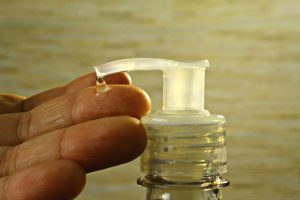- Slug: Antibacterial soaps, 550.
- File photos available (thumbnails, captions below)
By GAVIN MAXWELL
Cronkite News
PHOENIX – Arizona State University researcher Rolf Halden has been warning the U.S. Food and Drug Administration of the dangers of ingredients found in antibacterial soaps for more than a decade.
His research focuses on how man-made pollutants found in personal care products seep into our natural resources and eventually, our bodies. He said the FDA has been slow to react to the recommendations of environmental scientists, but the agency has finally taken action.
On Friday, the FDA issued its ruling on the safety and effectiveness of soaps and washes containing certain antibacterial chemicals. The ruling effectively bans 19 chemical compounds from the popular over-the-counter products.
Halden, the director of the Center for Environmental Security at the Biodesign Institute, called it a “public health victory.”
“It took over 40 years,” Halden said. “I applaud the FDA for finally ruling on it and ignoring industry lobbying.”
The FDA’s announcement states that companies can no longer market antibacterial washes containing these ingredients because manufacturers failed to demonstrate that the chemicals are safe for long-term daily use and more effective than regular soap and water in preventing illness. The FDA explained that some research shows long-term exposure to these ingredients, such as triclosan and triclocarban – the most common of the 19 chemicals used – can be harmful to public health.
Hand wash products containing these chemicals go down drains and into water treatment plants, where a considerable amount ends up in our groundwater supply, according to Halden’s research. The chemicals re-enter homes in drinking and bath water. In 2004, Halden and a team of researchers discovered triclocarban pollution in metropolitan areas across the nation.
“(Triclosan and triclocarban) are amongst the most abundant man-made pollutants. They are present everywhere, in our drinking water, urine, blood, breast milk and in newborns,” Halden said.
The prevalence of these toxins across the U.S. is due to their popularity amongst manufacturers. They have been popular additives to products for more than 40 years.
“Right now, the market consists of over 2,100 products and the vast majority of which do contain one of the 19 active ingredients,” said Andrea Fischer, a spokeswoman for the FDA.
Potential health risks include bacterial resistance, hormonal imbalances and increased chance of cancer, according to Halden’s research. Fischer said the FDA’s ruling sends a message that the potential health consequences of these ingredients outweigh the benefits.
However, some manufacturers claim these ingredients help to kill more bacteria than regular soap. These companies have not been able to produce enough scientific evidence to convince the FDA of their claims, Fischer said.
Meanwhile, some manufacturers are ahead of the FDA’s new regulation. She said two major manufacturers, Proctor & Gamble and Johnson & Johnson, announced on their websites that they would phase out triclosan in their antibacterial products prior to Friday’s ruling.
All manufacturers have one year to comply with the FDA’s new regulation. FDA officials said they hope the rule will curtail the level of toxins across the country.
“I certainly can say we detect (the 19 chemicals) wherever we look, and that includes here in Arizona. This ruling will have a local effect in limiting pollutants,” Halden said. “This is something that we are going to monitor to see what the effect of the ban is.”
For now, the FDA recommends keeping it simple and sticking to your old school soap and water.
^__=

